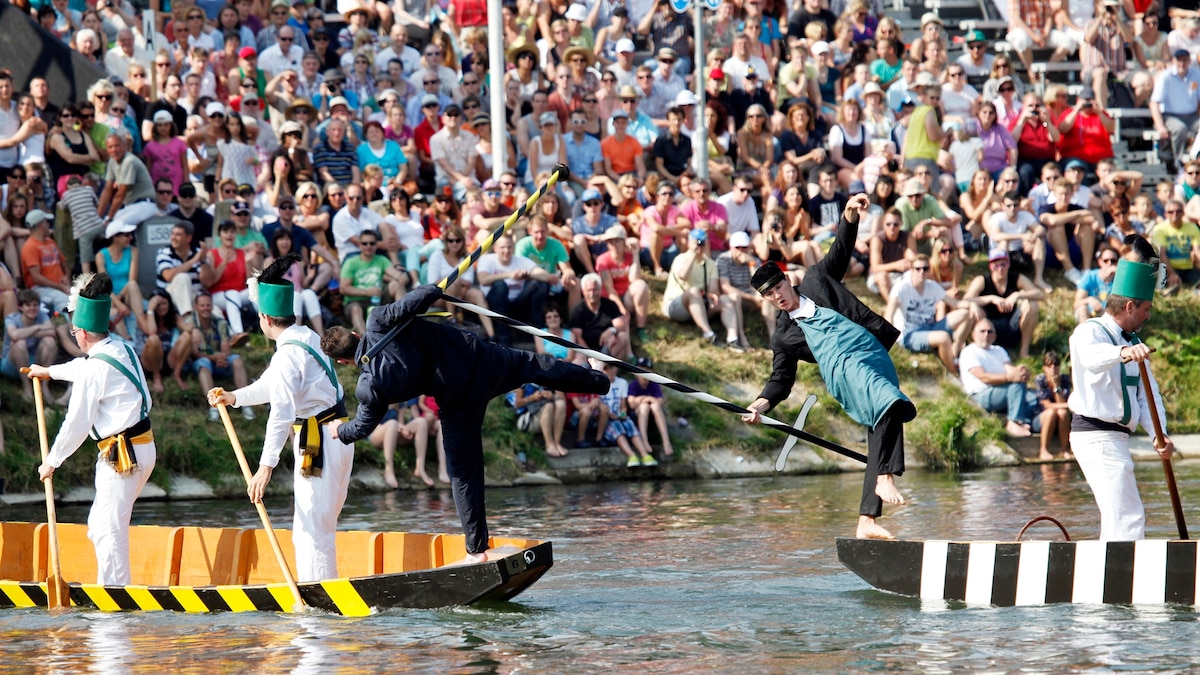This article was produced by National Geographic Traveller (UK).
As two flat-bottomed river boats steer towards each other from either bank, powered along by a crew of three oarsmen, thousands of knuckles tense. The route is short, the boats cutting swiftly across the Danube to the sound of pounding drums. All eyes are on the two costumed men, each standing at the stern of his boat with a lance positioned on his hip.
The aim: to thrust your opponent into the river. On this particular occasion, neither opponent is spared. Two well-placed stabs result in gasps, a theatrical splash and the cold, wet shock of defeat. The crowd, however, roars its approval, the cheers echoing off Ulm’s medieval walls. Then all eyes turn to the next pair already taking to the water.
You might be forgiven for thinking of a jousting tournament as a competition settled between metal-clad knights on horseback. This southern German city, however, urges you to think again. After all, Ulm was the birthplace of Albert Einstein and has always had a knack for thinking outside the box.
It is said by locals that the best feature about the Bavarian riverside is the view of Ulm’s skyline and its world-renowned cathedral, which took 513 years to be completed.
Photograph by Westend61; Getty Images
A piercing legacy
During the Fischerstechen (‘fisherfolk’s jousting’), fields are replaced with the Danube and horses with traditional boats, while opponents wear costumes inspired by local folklore. The quadrennial spectacle, held in July and organised by the century-old local fisherfolk’s guild in partnership with the city, has been a hotly anticipated occasion in the cultural calendar since as far back as the mid-16th century.
Participation is a family affair, reserved only for the descendants of Ulm’s original fishing families, and the premise is simple: 15 pairs of jousters go lance to lance over the course of two tournament days. In each round, two of the traditionally decorated fishing boats, steered by bargemen, start from opposing banks and pass each other in the middle. To stay dry and win the clash, each combatant must absorb the impact from the other while maintaining their balance (ducking and dodging is strictly forbidden). Certainly, no easy feat.
One aptly named jouster, Florian Fischer, has seven tournaments under his belt, having broken one rib and bruised two others during these short but intense bouts. “We don’t nudge, we pierce,” he explains. “We’ve always started from one side of the river and met with a very powerful push.” It’s a dynamic that separates Ulm’s version from other long-running water jousting tournaments dotted along the Danube, which see the combatants meet in the middle of the river and slug it out instead.
A highlight of the parade is the two jesters cheekily trying to interrupt the farmer’s dance with his wife.
Photograph by Stadtarchiv Ulm
“The guild’s insistence on the preservation of its history and portrayal of the tradition is unique,” Fischer explains. And it’s true, Ulm’s fishers’ jousting reaches a whole new scale. Each tournament day begins with music and a colorful parade across the city, with jousters and members of the guild performing in elaborate costumes. Starting at the city’s gothic Ulm Minster church, the procession marches past Central Library (a distinctive glass pyramid), through the old town’s romantic back streets and over its willow-strewn stone bridges.
It’s during this march that spectators first come face to face with the folklore and historic personalities they’ll cheer for on the water hours later. While most have been fixtures in the tournament’s line-up for hundreds of years, others have joined the cast more recently. Many represent notable figures from local battles or the city’s collective memory; one character who’s stood the test of time is the White Fisher, a spectral wraith dressed entirely in white who’s regarded as the guardian spirit of Ulm’s fisherfolk.
The 625-year-old restaurant ‘Zur Forelle’ (Trout’s Tavern) in the fisher’s quarters, has been run by one of the guild’s founding families since 1873.
Photograph by Maciej Noskowski; Getty Images
Following the current
As the tournament progresses, the balancing act becomes more urgent — and more slippery. Again and again, soaked jousters heave themselves back inside the little boats, puddles pooling in their wooden vessels.
But plunging into the Danube has become an honour and witnessing the spectacle part of this city’s DNA. “I’ve never given it any second thoughts. It’s always been a source of pride,” Fischer says, explaining how he’s followed in the footsteps of his father by stepping into his jousting role.
Other than glory, there’s no grand prize. “It’s simply part of being from Ulm,” Mayor Martin Ansbacher explains. “It goes beyond two men pushing each other into the water — it’s what makes up the spirit of the city.”
The dedication to the tournament’s heritage seems to run deeper — and longer — than the Danube. Missing it is out of the question. Fischer, however, takes it a step further: he always wants to be the first on site. “No one’s around. You might see the first few costumed figures appear, but I’m there first thing in the morning to see the water. To see how high it flows, how strong the current is. It’s a magical moment I always want to experience.”
How to do it
This year, the tournament takes place on 18 and 20 July. Tickets start at €10 (£8.50) per day to stand and €20 (£17) for a seat in the stands.
Getting there:
The nearest airport, Memmingen Airport, is serviced by multiple airlines, including Ryanair from Stansted and other locations in the UK. With a DB shuttle and train combination ticket, visitors can reach Ulm’s main train station in one hour for €23.30 (£20).
Where to stay:
Maritim Hotel Ulm is located on the banks of the Danube, a 10-minute walk from the historic fishers’ quarters. From €151 (£129).
To subscribe to National Geographic Traveller (UK) magazine click here. (Available in select countries only).
